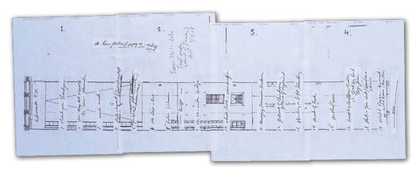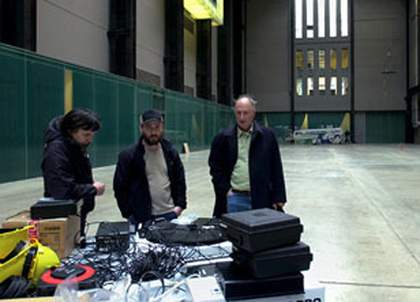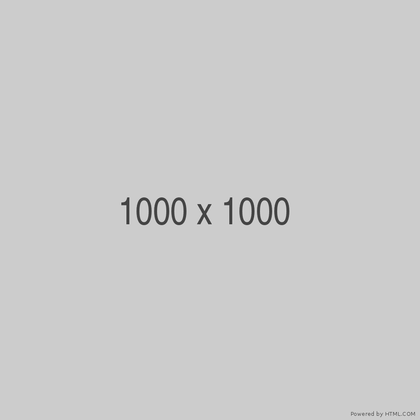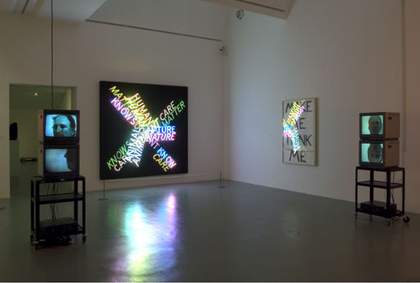Robert Storr
Could you describe how your Turbine Hall project got started? When and how did the idea come to you?
Bruce Nauman
I don’t remember exactly. I was asked by Tate whether I would be interested in making a proposal, but there was a time limit because if I didn’t want to do it, then they would need to approach someone else. So I went and looked at the space – and it’s extremely difficult. I came home and thought about it and decided I could do something with sound; that seemed the best thing for me. After a while I realised that instead of inventing new sounds, I wanted to use spoken text I had recorded over the past 30 or 40 years and make a kind of a collage. The people at Tate said that would be fine, so I got the materials together and went back when the space was finally empty. I was able to test some of the ideas and at that point really refine the way that I thought the project could work.

Plans for the Turbine Hall layout
Robert Storr
When you said you wanted to make a collage, did you already have an idea about which specific texts you were going to use and how they might relate to each other?
Bruce Nauman
No, I didn’t really know how they would connect. I had the idea of visitors walking into one area of sound and then into another. But it’s a very long, narrow space that is also one of the entrances to the museum, and halfway down you make a left turn to go into the galleries. So you have to do something to draw people further into the other half of the space. The idea of sounds coming from above and being isolated was a little problematic – how would visitors know to continue on into the rest of the hall? The first time I went there the equipment I had wasn’t working very well. Then we found a supplier who came up with flat panel speakers that were very directional. That was what I was looking for: working horizontally was much better than having the sound come from above – it’s as if when you walk through the space, you come through wave after wave of different texts. At this point there are actually about twenty texts, which create an overall ambient sound. When you walk into an area several metres wide the text is very clear. Then it becomes fuzzy as it merges with the next one, and then the next one becomes clear. There is always something going on to draw you into the space.

Bruce Nauman in the Tate Modern Turbine Hall, July 2004
© Tate Photography
Robert Storr
So the whole project is organised as a sequence of zones?
Bruce Nauman
Yes. The speakers are going to be mounted on the long walls of the Turbine Hall facing each other in pairs, so you walk through these bands of sound as you go down the ramp and into the space.
Robert Storr
Considering its size, the hall isn’t that wide.
Bruce Nauman
It’s roughly 150 metres long, but a mere 21 or 22 metres wide. My studio is only slightly narrower.
Robert Storr
In your Get Out of My Mind, Get Out of this Room 1968 the visitor enters on a central axis, but the side-to-side dynamic is very important. Standing in the middle of the room you hear a voice both to the left and the right, but the words are much sharper and more intense the closer you get to the speakers. So you set up this back and forth pattern of sound and of movement by the viewer. Was that installation a kind of aural prototype for this project?
Bruce Nauman
Yes.
Robert Storr
Given the arrangement of these bands of sound in the Tate piece, is there a point where you really hear nothing between them?
Bruce Nauman
No, there is always something. There will be a spot in-between where you’ll probably hear a little of this, a little of that, and then a little of everything. And there are the background sounds of the building and of the people in there talking. We’re also going to hang overhead diffusion speakers that will spread a kind of a white noise over the whole space to mask some of the echoes. But these are all things that need to be tested and worked on.
Robert Storr
It’s sort of the sound equivalent of a person painting or drawing in strong lights and darks around a pre-existing middle tone. You’re establishing a bass line or drone that is actually a composite of several different pieces. Does this mean adjusting the original tapes in terms of pitch or volume?
Bruce Nauman
Yes, we’ll probably have to do that, but we won’t know until we’ve completed the tests. We’ve done enough for me to imagine it’s all going to work.
Robert Storr
Still, the next run-though may have its white-knuckle moments.
Bruce Nauman
I really want to use Rinde Eckert singing from Anthro/Socio 1992, but that’s such an intense tape that I have to be careful it doesn’t take over the situation. If it can’t be controlled, it might not work in the context of the whole room. I’ve got enough spare texts if some just aren’t appropriate.
Robert Storr
How many different voices will you actually have speaking at once? For example, your video installation World Peace has about five or six monologues going on simultaneously.
Bruce Nauman
I’m going to use only two of those voices. Because the speakers are very directional, they are just as loud 50 feet away as ten feet away. As they walk down the hall people would normally gravitate towards the origin of the sound. If you have a speaker on each side broadcasting the same text, they tend to stand in the middle of the room. That’s more comfortable and I prefer that idea. In some cases, though, I’ll have a different voice on each side with the same text – more like some of the original installations. In other cases, it will be the same text broadcast on both sides.

Recordings from the past 30 or 40 years make up Nauman's sound collage
© Tate Photography
Robert Storr
Do you have any thoughts about how the patterns of movement of visitors – how they accumulate in or are dispersed throughout the space – will affect the work? I gather the way people positioned themselves in Olafur Eliasson’s The Weather Project determined how the whole piece was experienced.
Bruce Nauman
Yes. The ramp covers a little less than half of the space and keeps people moving. In the Eliasson piece, they didn’t stop there so much. They gravitated towards the sun image at the far end where the floor is level, congregated there and started doing things. I can’t pretend to imitate that kind of situation. Some of my texts are very short and repetitive, so you get them pretty quickly and move on. Others are long and quite intense, but I don’t necessarily expect people to stay and try to listen to the whole thing. Some texts are going to be reinforced, some will lose a lot compared with my original intentions, but I think that’s okay. I’m just going to let that happen, however it happens. They’re out of context, so they become a whole new kind of experience.
Robert Storr
In Anthro/Socio, Get Out of My Mind, Get Out of this Room and a number of your other works the texts are repeated, but the voices change register and there are striking cadences and overlays. You hear the words and get the explicit meaning, but there’s also an emotional response to the overall musicality of the piece.
Bruce Nauman
I think this installation is going to reinforce the musicality and the emotional content, rather than the intellectual content.
Robert Storr
With all your concern for these phrasings and intervals in mind, is this piece really a musical composition to a greater extent than was true of any of the individual parts you’re using to make it?
Bruce Nauman
I’m using these otherwise finished texts as raw material for a whole other idea. What I’m doing is saying: ‘Okay, forget what the original intention was, just use this stuff as sound that is available and arrange it in some way that makes another kind of sense.’ We’ll have all the texts, we’ll have the space and we’ll have enough speakers, and we’ll be able to begin the process. I’ve made a programme of the way I think I want it to work – this one goes with that one, this is the next one – but it may be totally inappropriate when I finally start to walk through it and hear it. I can change things around, maybe delete some and add others. There’s no other way to do it, except in that space. I can guess in pairs here in the studio, but I can’t make the ensemble.
Robert Storr
About two years ago I saw Bob Dylan in concert and he sang a lot of his early material – story songs and songs with messages – but in this really interesting, kind of flat, very rapid cadence, as if he were purposefully going against the explicit meaning of his lyrics to get something else out of the music. It was like he was treating the words as the basis for jazz improvisation. Dylan’s not the model necessarily, but it seems a little bit like what you’re up to – taking old work and rephrasing it in a way that sounds utterly different.
Bruce Nauman
Yes. Because basically he’s taking his stuff out of the original context and using it in another way, as something to work with, without giving weight to its original intention. Or he’s trying to do that – it’s not that simple.
Robert Storr
Is it stretching things to say that what you’re doing is basically using sound as sculptural material, and experimenting with it to find out how manipulable or malleable it is within given spatial dimensions?
Bruce Nauman
When I was trying to explain this idea in one of the meetings we had at Tate, they said it’s like sampling, and in a way it is. But that seemed too simple, because it’s my own work that I’m using, rather than just choosing this or that.
Robert Storr
Is there any aspect of making what is effectively a sound retrospective that is particularly surprising or unsettling?
Bruce Nauman
It’s been easier than doing a normal retrospective. I’m not as emotionally involved with the individual pieces as I would be if I were trying to re-install each one. I’m using this stuff in a kind of abstract way, or pretending it’s abstract and allowing almost random associations to appear. At one point I thought, well, I can do this chronologically. But it doesn’t seem correct in that people are coming into the space directly from the entrance of the museum. You have to arrange it so they can adjust to what’s going on, and not do complex things immediately. I want to start with Thank You, because it’s just that simple word repeated. You don’t want to do The Consummate Mask of Rock as soon as people step in the door – they’re going to go right by it.
Robert Storr
Will you make any physical alterations to the space, or will it remain essentially a huge empty box? Will the speakers be visible on the wall?
Bruce Nauman
They’ll be visible, but they won’t be very obvious. I’m going to mount them on the phalanges of the I-beams so they won’t protrude into the space. You’ll see these flat cardboard things, which are the speakers.
Robert Storr
So you’ll feel the physical volume of the space in relation to the volume of sound, and that’s it?
Bruce Nauman
Yes. There will be two places, under and on top of the bridge, where the sound will come from above. In the rest of the hall it will be coming from the sides.
Robert Storr
You talked about the sequential progression of sounds. Are you also thinking about sequencing the tapes in terms of their logical or emotional content in a way that they might be construed as a cumulative proposition or statement?
Bruce Nauman
Up to this point I’ve tried to go from short intense pieces to longer, quieter ones, so it modulates all the way down the length of the hall, but until I actually install them, I won’t know if that’s the best way to do it.
Robert Storr
But are you considering using these disparate texts to summarise an idea? Are you working with that possibility, or just ignoring it?
Bruce Nauman
Well, ignoring it – because of the way the space is set up. I really thought about that a lot, especially in terms of where you enter the museum from the space underneath the bridge. I don’t want people to jam up there. I want them to feel like they can go through that area and congregate to listen to some longer text.
Robert Storr
How does this project fit in with the rest of your current work? For example, recently you have been casting fish and making fountains out of them. Does a commission or an unexpected opportunity of this sort constitute a parenthesis within what you’re thinking or doing in other domains, or does it just become a part of a flow of ideas?
Bruce Nauman
It’s part of a whole flow of ideas. I was working on this fish project, so I did consider making a large-scale version of it, but given the amount of time I had to work on the Tate installation – a year – that seemed unlikely to happen. I would have needed a number of years. The only other thing that occurred to me was that because there are these cranes in Tate Modern, and because the first time I saw the space there were Henry Moore sculptures in it, well, I could pick the Moores up and start flying them around.
Robert Storr
Maybe you should be the first artist to do two Unilever projects in a row. It would be a wonderful sight – an aerial ballet of sculptures that are, by design, so emphatically earthbound: ‘Henry Moore Bound to Fly’. But let’s go back to the question of the role that commissions and projects play in the normal rhythm of your work.
Bruce Nauman
Well, I certainly turn down many more than I take on. If this project hadn’t come to me in the way it did, I think I might not have done it. I’ve had misgivings. We’ve had a lot of technical problems with speakers and setting this thing up, and, you know, I’m not in the electronics business here. I did think about other ideas, but I didn’t have a really clear large physical or sculptural idea. It’s a tough space. You can’t mock it up anywhere else.
Robert Storr
But the space has inspired the artists who agreed to take it on to produce interesting things, even when they haven’t been 100 per cent successful. Nobody’s faked it so far.
Bruce Nauman
No, you can’t.
Robert Storr
When was the last time you showed in England; was it at the Hayward Gallery exhibition in 1998?
Bruce Nauman
Yes.
Robert Storr
Have you had any time to look around and see what is going on in London, because it has certainly changed a lot in the past ten or fifteen years?
Bruce Nauman
I’ve really enjoyed the times I’ve been in London. I haven’t seen a lot of art, but some. I always go to the National Gallery. And the weather’s been great every time.
Robert Storr
There’s a wonderful passage in Virginia Woolf ’s Orlando where she talks about the glorious, bright and sunny Elizabethan age, and how, after that, the clouds descended. Maybe the clouds are finally going away.
Bruce Nauman
Well they said I could come back anytime I wanted to, because it’s always supposed to be raining, but when I get there the sun comes out.
Robert Storr
Does London seem like an exciting place to be producing art now?
Bruce Nauman
Yes. It’s different from New York.
Robert Storr
In what way?
Bruce Nauman
I can’t say exactly, but there’s a really different attitude about what art is supposed to be about and how it’s supposed to function. I was amazed at the number of people that go through all the floors of Tate Modern, and then there’s Saatchi’s place. And there are works shown in London, maybe with a little disclaimer – ‘your children might not want to look at this’ – that they’d have a hard time putting up in the States. The British don’t seem to have that problem.
Robert Storr
England is wide open. Things are happening very fast and the public is actively engaged. It’s enjoying an early phase of an incredibly dynamic arts scene, and the energy seems to override the sour or dubious aspects of that scene.
Bruce Nauman
I think maybe it’s like the boom of painting in the 1980s. There was a lot of bad stuff, but prices went up and that brought everything up. It brought a lot of people into galleries and into museums. So that’s terrific. There might be crap and mistakes, but so what? You need that. It’s great.
Robert Storr
We could do with a little more ferment in the States, but I’m afraid we’ll have to wait.
Bruce Nauman
Yeah, I think we’re going to have to wait.

